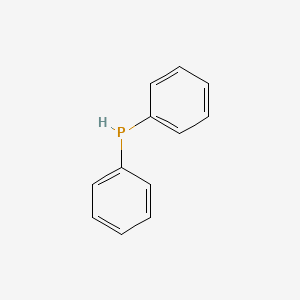Your Location:Home >Products >Organic phosphines >Phenyl phosphines >829-85-6


Product Details
|
Description |
Diphenylphosphine is an organophosphorus compound commonly used in laboratories, characterized by its clear, colorless to slightly yellow appearance and unpleasant odor. It is highly reactive, easily oxidized in air, and can spontaneously combust, thus requiring protection from air and light, typically under nitrogen. |
|
Uses |
As a precursor in the synthesis of various organophosphine ligands, Diphenylphosphine plays a crucial role in homogeneous catalysis applications such as asymmetric hydrogenation, coupling reactions, and polymerization of alkenes. Diphenylphosphine is produced by deprotonating Ph2PH to obtain diphenylphosphide, which can then be used to create novel phosphine ligands, Wittig-Horner reagents, and phosphonium salts. It is also valuable in organic synthesis, particularly in the preparation of pesticides and chiral phosphine ligands. The compound can be synthesized from triphenylphosphine through reduction to lithium diphenylphosphide, followed by protonation. |
|
Chemical Properties |
Diphenylphosphine is an organophosphorus compound commonly used in laboratories. It is a clear colorless to slightly yellow liquid with unpleasant odor, irritating, easily oxidized in air and spontaneously combusts, sensitive to air and light, and needs to be protected by nitrogen. It can be used as a precursor for the synthesis of a variety of organophosphine ligands. These ligands, in turn, are used in homogeneous catalysis for many applications including: asymmetric hydrogenation, coupling chemistry, ethylene oligomerization, hydroformylation, hydration of nitriles, and polymerization of alkenes. |
InChI:InChI=1/C12H11P/c1-3-7-11(8-4-1)13-12-9-5-2-6-10-12/h1-10,13H
Two novel host materials based on the diphenylphosphine oxide (DPPO) and spirofluorene were designed and facilely synthesized by tuning the ratio of donor spirofluorene units and acceptor DPPO units from 1: 1 to 1: 2, i. e., (4-(9,9′-spirobi[fluoren]-2-yl)phenyl)diphenylphosphine oxide (SPDPPO) and (9,9′-spirobi[fluorene]-2,7-diylbis(4,1-phenylene))bis(diphenylphosphine oxide) (SBPBDPPO). Furthermore, 3,6-disubstituted spirofluorene possesses better thermal stability performance, for instance, higher glass transition temperatures (SPDPPO of 140 °C and SBPBDPPO of 172 °C).
-
The reaction of indium(III) salts with P...
The invention relates to the field of ne...
The utilization of phosphirenium ions is...
2-Amino-6-bromopyridine

triphenylphosphine

6-(diphenylphosphanyl)-2-aminopyridine

diphenylphosphane
| Conditions | Yield |
|---|---|
|
triphenylphosphine; With ammonia; sodium; at -78 ℃; for 2h;
2-Amino-6-bromopyridine; In toluene;
|
59% |
chloro-trimethyl-silane

potassium diphenylphosphine

1,1,3,3-Tetraphenyl-2-trimethylsilyl-triphosphan

(trimethylsilyl)diphenylphosphine

Tetraphenyldiphosphin

diphenylphosphane
| Conditions | Yield |
|---|---|
|
With phosphorous; Multistep reaction; 1.) toluol, -78 deg C, 2.) toluol, r.t.;
|
phenyl diphenylphosphinite
chloro-diphenylphosphine
Diphenylphosphinic chloride
diphenylisothiocyanatophosphine
dimethyldiphenylphosphonium iodide
Tetraphenyldiphosphin
(2-cyanoethyl)diphenylphosphine
diphenyl-phosphinic acid
CAS:98327-87-8
Molecular Formula:C<sub>44</sub>H<sub>32</sub>P<sub>2</sub>
Molecular Weight:622.7
CAS:4559-70-0
CAS:41593-58-2